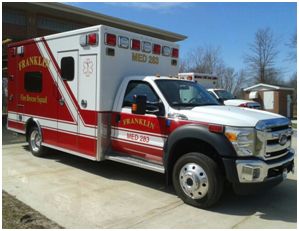EMS Service Rates
The Franklin Fire Department participates in a County-wide EMS system that provides consistency of medical direction, quality control, initial and continuing education, and access to emergency medical services to all Milwaukee County residents. (More information on the Milwaukee County EMS System.)
In 2014, EMS-related responses accounted for 2,863 of the Franklin Fire Department’s 3,586 total Calls for Service. This 80% EMS to 20% Fire reponse ratio is typical for fire departments that provide both Fire and EMS responses. All FFD personnel are trained as EMT-Basics, and nearly all department personnel are licensed to provide the higher EMT-Paramedic level of care. Additionally, every emergency response vehicle, whether fire engine, ambulance, or command vehicle, are equipped to provide some level of on-scene medical care.
Basic and Advanced Life Support
FFD provides both “Basic Life Support” (EMT) and “Advanced Life Support” (paramedic) level response, treatment, and patient transport. The department staffs two BLS ambulances. BLS units are staffed by a minimum of two firefighter/EMTs, with initial training of approximately 180 hours. EMTs must also attend continuing education throughout the year order to maintain their licensure.
 |
FFD currently has an ALS ambulance stationed at each of the city’s three fire stations. ALS ambulances are able to treat the most serious patients, essentially “bringing the Emergency Room to the patient”. FFD firefighter/paramedics can initiate intravenous access, give medications, and insert a breathing tube into a patient’s airway to assist in ventilation.
|
|
FFD firefighter/paramedics can administer and interpret 12-lead ECGs, allowing them to diagnose and treat cardiac events. Paramedics go through approximately 1,800 hours of initial training, and must attend periodic refresher and continuing education classes in order to update their knowledge and skills, and stay to atop of constantly changing trends in medical science and practice. Training FFD’s final few EMTs to the paramedic level - making FFD an “all-ALS” fire department - is a high priority for 2015.
Tiered Response Model
An ambulance call can range from a simple “help up” call to assist an elderly or disabled resident, to a full cardiac arrest or a multiple-patient trauma incident. FFD uses a “tiered response” triage and computer-aided dispatch model to ensure that the resources that respond are appropriate for the severity of the reported illness or injury, and that the closest available unit is dispatched to the call. Dispatchers screen 911 calls as they come in, asking relevant questions in order to determine what level of care is required. Generally, BLS units are dispatched for less-serious calls, keeping ALS units available for truly life-threatening emergencies.
Regardless of the type of call that they are dispatched on, FFD paramedics and EMTs work together seemlessly and with the highest degree of professionalism. The most serious medical calls, such as a cardiac arrests, require teamwork and coordination. Each team member has a particular job to do and function to perform, and many procedures must be done quickly and simultaneously if the patient is to have a chance at survival.
|

EMS Continuing Education
In 2012, Milwaukee County EMS went to a web-based continuing education module, essentially using interactive teleconferencing technology to replace classroom sessions. In 2014 this system was enhanced through a county-wide federal grant acquisition initiated and administered cooperatively through MC EMS and the Milwaukee Fire Department. FFD received upgraded teleconferencing equipment, and a higher-quality interactive teleconferencing platform at minimal cost to City of Franklin taxpayers. This allows all continuing education to be conducted entirely on-duty through a combination of videoconferencing and a web-based training and records management platform called Target Solutions. FFD administration uses the pre-prepared Target Solutions training modules (though with slightly less rigorous subject content) to meet the educational requirements in order to maintain EMT certification for those who are not trained to the Paramedic level.
The following is a sample of the minimum biannual training requirements to stay certified at paramedic level:
|
Advanced Medical Assessment
|
4.0 hours |
|
Advanced Trauma Assessment
|
4.0 hours
|
|
Airway
|
2.0 hours
|
|
Pharmacology
|
2.0 hours
|
|
Venous Access and Medication Administration
|
2.0 hours
|
|
Cardiology
|
2.0 hours
|
|
12-Lead Interpretation
|
1.0 hours
|
|
OB/GYN
|
1.0 hours
|
|
Operations
|
2.0 hours
|
|
Weapons of Mass Destruction Preparedness
|
2.0 hours
|
|
Pediatric Medical/Trauma Assessment
|
8.0 hours
|
|
Flexible Content
|
18.0 hours
|
| Total |
48.0 hours |
MCEMS Studies and Trials
The Franklin Fire Department and MCEMS participate in research in order to further enhance the quality of care delivered and to improve outcomes for the citizens of Milwaukee County. In 2014, Milwaukee County EMS and the Franklin Fire Department continued their participation in the National Institute of Health (NIH) sponsored Rescusitation Outcomes Consortium – more commonly knowns as the “ROC” studies. The stated goal of the consortium is to continuously “study the impact of promising clinical interventions on survival for patients with severe traumatic injury and cardiac arrest”. These studies are conducted at test sites (primarily urban centers with high-quality regional EMS systems in place) across the US and Canada.
It is important to note that some of these field studies meet the National Institute of Health (NIH)’s and FDA’s requirements for “Exception from Informed Consent” (since the victim is unresponsive and not able to consent to their treatment at the time of the emergency).